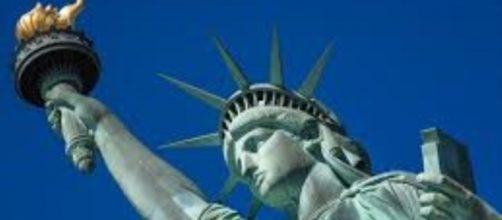When Donald Trump’s senior policy advisor Stephen Miller took the podium at a White House press briefing last week to announce a proposal for merit-based immigration (translation: only self-supporting and English-speaking may apply), he got pushback. CNN’s Jim Acosta pointed out that the policy ignores Emma Lazarus’ sonnet engraved on the base of the Statue Of Liberty that begins “Give me your tired, your poor, your huddled masses yearning to be free...” Miller said those words didn’t count because they were “added later.” But suggesting that they’re not part of the original statue as if to say that they’re not integral to it, is delusional.
Getting history wrong
The poem’s connection to Lady Liberty is well-documented. When the French gifted the U.S. with The Statue, we needed to purchase a pedestal. To raise funds, Lazarus was enlisted to pen a poem about how Lady Liberty holds her torch out to refugees. Granted the poem was engraved at a date later than the installation, but the words were site-specific. Suggesting that Lazarus’ welcoming message was an afterthought is a fiction.
Missing the point
And while France’s gift was intended as an emblem of America lighting the way to liberty, that was not the only way that Americans came to see it. Lazarus’ words about “the wretched refuse of your teeming shores” and the “homeless, tempest-tossed” form the polar opposite sentiment to merit-based immigration.
As the American historian John T. Cunningham has written, Lazarus's poem “permanently stamped on Miss Liberty the role of unofficial greeter of incoming immigrants."
Catcalls
Statues that started out one way in the public mind and end up another way are not uncommon. Consider the pink marble lions flanking the New York Public Library grand entry stair on Fifth Avenue. At first, they were a roaring flop. No one seemed to like them. Theodore Roosevelt said he preferred moose or elk. Newspapers dissed them as “absurd” and “mealy-mouthed.” Even the traditionally reserved New York Times got nasty, saying the lions look like what “a biologist would expect to get from crossing a dachshund with a Welsh rabbit.” Piling on, the Times also characterized the lions as a cross between a hippopotamus and a cow.
Patience and fortitude
But over time, the sculptures went from scapegoats to lion kings. Located at one of the city’s busiest intersections, the jungle cats became a landmark and a rendezvous point and more. New York’s Mayor Fiorello LaGuardia named them Patience and Fortitude as symbols of the people of his city. In the end, what is said of public art is not always the last word. The Trump administration can’t rationalize an immigration policy that allows only the financially independent by dismissing Lazarus’ poem as a nonsequitur. Her words are Lady Liberty’s bottom line.


